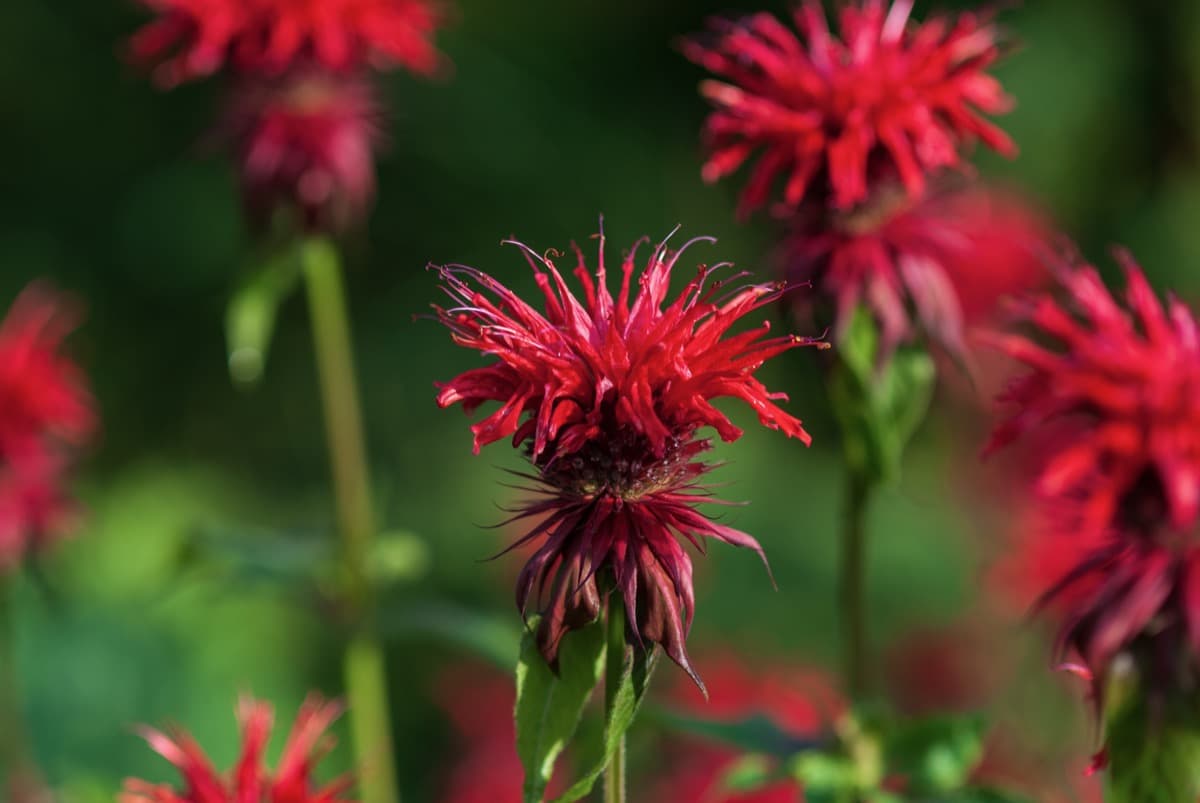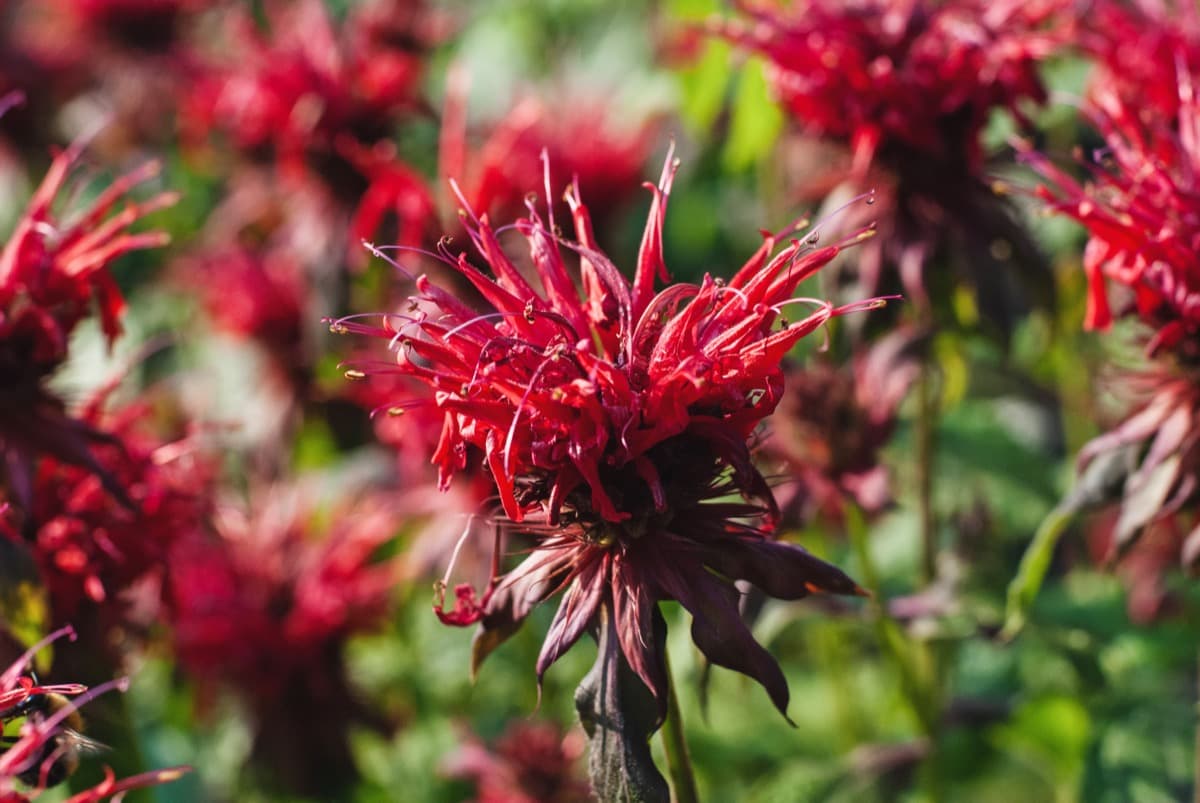Scarlet Bee Balm is a vibrant perennial that attracts beneficial insects like bees, hummingbirds, and butterflies to your garden. Learn how to grow and care for this beautiful plant with our detailed guide, covering everything from planting seeds to maintaining it. While Scarlet Bee Balm can be a bit finicky at times, it can become a stunning focal point in your garden landscape with the right conditions and careful tending.

How to Grow and Care for Scarlet Bee Balm
Best Soil Conditions for Growing Scarlet Bee Balm
Like many garden favorites, Scarlet Bee Balm prefers well-drained soil. Excessive moisture can lead to powdery mildew and other bee balm problems, so providing an environment that prevents such issues is essential. When selecting a site to plant your bee balm, ensure the soil is rich in organic matter.
If your garden has heavy clay or sandy soils, consider amending it with compost or well-rotted manure to improve its texture and nutrient content. Bee balm thrives in soil with a pH of 6.0 to 7.0, which is the ideal acidity level for its growth. Furthermore, it’s best to plant bee balm in a spot not already occupied by plants susceptible to similar diseases, such as roses or tomatoes, as this can help prevent the spread of infections.
Watering Requirements for Scarlet Bee Balm Plants
While it’s true that Scarlet Bee Balm can tolerate short periods of drought once established, it’s also important to provide regular watering for this plant, especially in its first year of growth. Doing so ensures the bee balm blooms the first year and sets the plant up for success in the following years.
The key here is balance. Bee balm prefers soil that’s consistently moist but never waterlogged. Excessive watering causes root rot, while insufficient watering stresses the plant and limits blooming. A good rule of thumb is to water deeply once a week, adjusting based on rainfall and temperatures. During hot, dry spells, your bee balm may require more frequent watering.
Sunlight Needs for Healthy Scarlet Bee Balm Growth
The answer is a bit of both in the age-old debate of bee balm, sun, or shade. Scarlet Bee Balm plants do best in full sun to partial shade. While they can handle full sun conditions, they appreciate afternoon shade in hotter climates to protect them from scorching. Morning sunlight and afternoon shade are typically ideal for a location. With proper sunlight, these plants can reach their full height, with some varieties of bee balm growing quite tall. Indeed, the question of how tall bee balm grows can have a wide range of answers, with some varieties reaching up to 4 feet tall.
Pruning and Deadheading Scarlet Bee Balm Flowers
Proper pruning and deadheading are essential aspects of bee balm care. These techniques help the plant look its best and promote better air circulation, which can prevent many common bee balm problems. Pruning aims to remove dead or diseased plant parts. It’s best done in early spring. Regularly remove spent blooms (deadheading) during the flowering season to promote more flowers and prevent excessive self-seeding.
Natural Pest Control Methods for Scarlet Bee Balm
While Scarlet Bee Balm is relatively pest-resistant, it can sometimes attract aphids and spider mites. These pests can be controlled by rinsing the plants with a strong jet of water or applying a homemade insecticidal soap. Consider installing a fence or using a natural deterrent for larger pests like deer and rabbits.
Moreover, beneficial insects attracted by bee balms, like ladybugs and lacewings, can help keep pest populations in check. However, the disease tends to be a more significant issue for bee balm than pests. Powdery mildew, in particular, can be a common problem. Selecting resistant varieties, ensuring good air circulation around plants, and watering at the base rather than overhead can help prevent this issue.
In case you missed it: How to Grow and Care for Red Valerian: Planting Instructions

Fertilizing Techniques for Robust Scarlet Bee Balm Plants
Regular fertilization is a must to keep your Scarlet Bee Balm healthy and vibrant. In spring, a well-balanced fertilizer slowly releases nutrients to support plant growth and blooming. However, it’s essential not to over-fertilize, as this can lead to lanky growth and fewer flowers. Using organic matter as mulch can also help feed the plant while keeping the soil moist and suppressing weeds. Always follow the manufacturer’s instructions when applying fertilizer, and don’t forget to water thoroughly after each application.
Winter Care Tips for Scarlet Bee Balm
Winter care for Scarlet Bee Balm depends largely on your climate. In areas with mild winters, little to no extra care may be needed. However, a bit more preparation is required in regions where the ground freezes. After the first frost, cut back the stems to about 2 inches above the ground. Then, apply a thick layer of mulch over the plants to insulate them from the cold. This protects the plant and improves the soil’s health as the mulch decomposes. Come spring, remove the mulch to allow new growth to push through.
Propagation Methods for Expanding Your Scarlet Bee Balm Garden
The process is fairly straightforward if you’re wondering how to grow bee balm from seed. Start seeds indoors 8-10 weeks prior to the last frost or sow them outside after frost risk is gone. Keep in mind that bee balm seeds require light for germination, so avoid burying them too deep. Another option is dividing and propagating bee balm in early spring or autumn. Just dig up the plant, separate it with a knife or spade, and replant the divisions. This method also helps control the size of mature plants, as bee balm can spread aggressively if not managed.
Companion Plants That Thrive Alongside Scarlet Bee Balm
Plants that do well alongside Scarlet Bee Balm include those that enjoy similar conditions, such as Black-Eyed Susans, Coneflowers, and Yarrow. These plants add diversity to your garden and can help attract even more pollinators. However, it’s crucial to be mindful of what not to plant with bee balm. Avoid planting bee balm near plants prone to similar diseases, like roses or tomatoes, to prevent the potential spread of fungal infections. Also, give bee balm and its companions enough space to ensure proper air circulation.
In case you missed it: How to Grow and Care for Salvia: Planting Instructions for Better Blooms

Conclusion
Growing and caring for Scarlet Bee Balm can be a rewarding gardening experience. While this plant requires a bit of attention, it can flourish and become a true showstopper in your garden with the right care. Remember to provide the correct soil conditions, adequate water and sunlight, and proper pruning.
Monitor for pests and diseases regularly, feed with an appropriate fertilizer, protect it during winter, and consider propagation methods for expanding your bee balm garden. Choose companion plants wisely, and you’ll have a vibrant, pollinator-friendly garden that’s the envy of your neighborhood.
- Ultimate Guide to Ossabaw Island Hog: Breeding, Raising, Diet, and Care
- Ultimate Guide to Juliana Pig: Raising Facts, Size, Diet, Care, and Lifespan
- Raising Lleyn Sheep: Disadvantages, Price, Uses, Characteristics, and Care
- Ultimate Guide to Meishan Pig: Breed Facts, Breeding, Raising, and Care
- Ultimate Guide to Teacup Pigs: Raising, Diet, Lifespan, Cost, and Care
- Guide to Raising Poll Dorset Sheep: Facts, Profile, Characteristics, Uses, and Care
- Ultimate Guide to Bighorn Sheep: Characteristics, Diet, Lifespan, Breeding, and Lifecycle
- Ultimate Guide to Raising Katahdin Sheep: Farming Facts, Breed Profile, Uses, and Care
- Ultimate Guide to Raising Oreo Cows: Belted Galloways Farming Facts, Profile, Uses, and Care